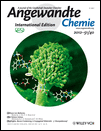Back Cover: The Impact of Ligand Reorganization on Cerium(III) Oxidation Chemistry (Angew. Chem. Int. Ed. 40/2012)
Graphical Abstract
The control of ligand reorganization is a new design strategy for cerium(III) redox chemistry, and allows for the prediction of reaction products. In their Communication on page 10159 ff., P. J. Walsh, E. J. Schelter, and co-workers report alkali-metal/cerium heterobimetallic complexes that modulate ligand reorganization. The picture shows electron transfer between two complexes near the planetoid Ceres, under the watchful gaze of the eponymous goddess.





